Ever heard of soap on a rope? How about a dope on a rope — or a sled on a rope? When they told me lot’s of people on Denali pull gear sleds on a rope, I knew right away that wasn’t the way to go if you’re on skis. I’ve done it. In my experience, pulling cargo on snow with a rope works on a nice constant uphill pitch, but glide over a roller or head downhill, and you’ll have a 50 lb artillery shell headed straight for the backs of your knees. You can try to depend on your crevasse roped partner to control the thing, but he’s on skis too and isn’t going to be carefully belaying your sled down behind you while he tries to stay upright and watch for his own load. The solution is easy, sort of. Use a purpose built gear sled with rigid rods. But how do you attach those to your pack or harness, and is the stock configuration the way to go? Nope, not for us. Check out the evolution.
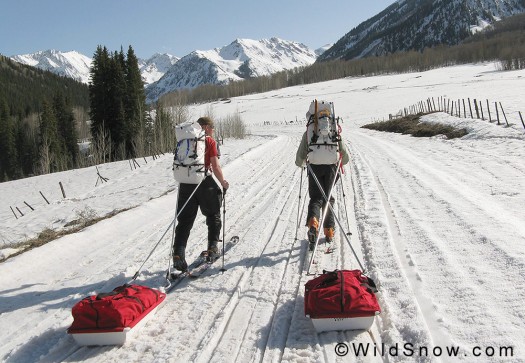
Out on a training and testing slog with our CiloGear packs and gear sleds. It took a few of these trips to get there but I think we've got our systems figured out. Click image to enlarge.
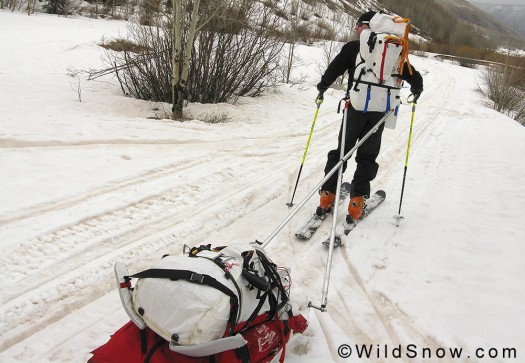
The full configuration involves ergonomically correct attachment to the backpack, crossed rods for stability and natural turning, and some sort of flexible joint where the rods connect to the sled. Click image to enlarge.
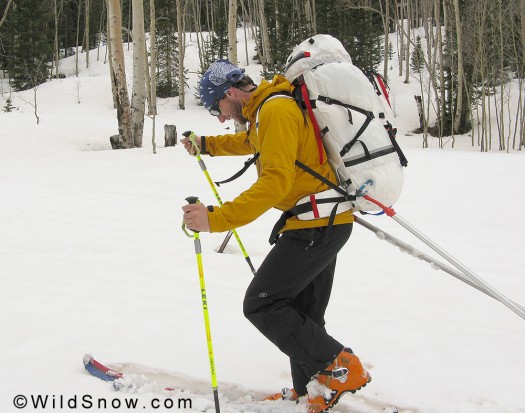
Side view show how the rod ends are attached to the CiloGear 75L Dyneema Worksack in close to the skier's body. If the rods are attached farther rearward on the pack the pull becomes inefficient due to oscillation of the pack mass. Conversely, attaching to the sides of the waist belt is uncomfortable, and makes the pack difficult to remove if the rods are under tension.
Perhaps the biggest dilemma with expedition pulk use is whether you pull with the sled attached to your pack, or use a dedicated harness. Either way works if you tune everything at home. But on a glacier you’ve got a climbing harness. Add your pack waist belt and your pulk harness belt to that, and you may have a problem keeping everything working together without it feeling like torture due to bulk and complexity. Instead, for a sled attachment point CiloGear built a small loop of webbing into our 75L Dyneema Worksack Dyneema backpacks, located next to the “triangle” where the shoulder strap anchors. This location is close enough to your body so as not to cause the pack to oscillate as you walk.
A defining feature of CiloGear packs is how you configure them using small steel and plastic clips that “keyhole” through each other. As variations of that, our final version of attaching our sleds is to use a 5/16 eyebolt located at the ends of the rods. The CiloGear clips keyhole nicely through the screw eye (after expanding it a bit while building), and likewise we can pull the webbing anchor through the eye and simply pin it with a ‘biner (this method is awkward with a full pack and heavy sled, see below for another method). The eyebolt is attached in such a way as to allow us to bend the ends of the rods so they clear the wider part of the backpack.
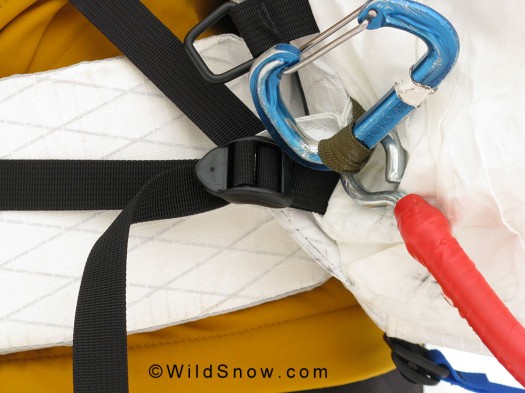
Simple sled attachment on CiloGear pack keeps the forces close to your body to keep the pack stable as you trudge -- and solid as you ski. This attachment method does have a tiny bit of play, but it's minimal.Final version of rod has more tape to prevent abrasion, the the pack is protected by a patch of Seam Grip.
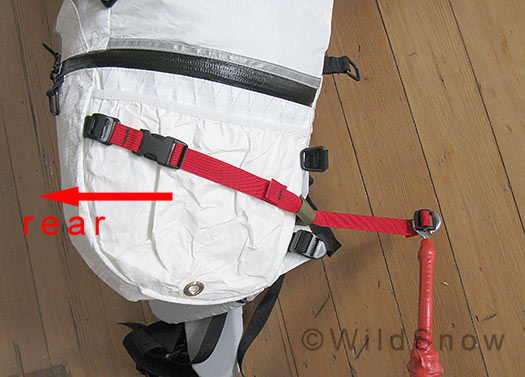
The better method of attaching our eyebolt equipped rods begins with a CiloGear compression strap, which is passed through the anchor on the pack then keyholed into the eyebolt. You then tighten the compression strap for a play free attachment. Huge advantage of this method is it's very easy to get the rods on and off the pack even if heavy loads or awkward positions bind things up.
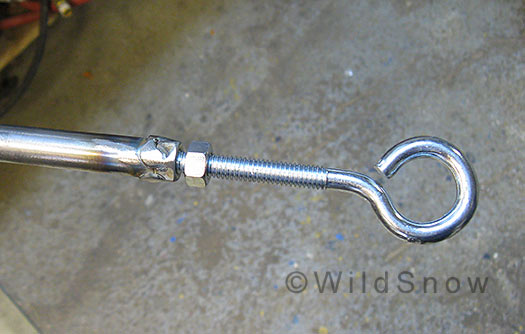
We installed the eyebolts by making adapters out of steel tubing with a nut welded on the end. the eyebolt is then installed with some Loctite and a lock nut. We found that longer rods add a lot of efficiency as well, due to the front of the sled getting a lifting force rather than a pulling force if the rod angle is too steep. Thus, while making the adapters we also added some length to our rods.
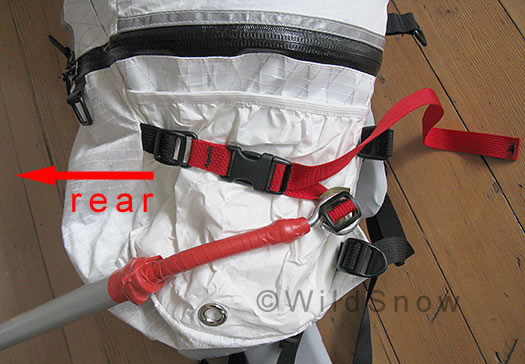
Compression strap sled attachment method with strap tightened. Zero play, easy to slack the system and remove the rods by simply loosening the strap or popping the buckle open. Only improvement we can think of is to have some sort of quick release on the actual attachment point.

Key to the ergonomics and overall success of this system is the ends of the rods being bent to clear the backpack.
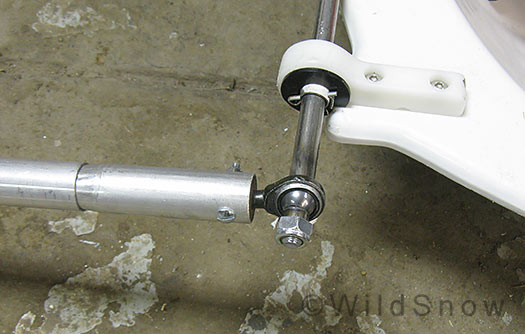
Key for skiing with a sled is to have flexible rod attachment at the sled as well as your pack. In Louie's case, we went for it and used these small heim joints for a flexible connection that doesn't fold up the way rubber hose does. We really like this system, but it's time consuming and expensive to cobble up. You can source the heim joints at a Yamaha snowmobile dealer, they're steering joints.
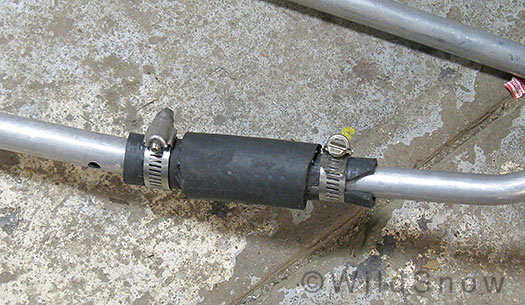
A common method to add a flex joint to ski sleds is to use a section of rubber hose. Garden hose works but is fragile when it gets cold. We did better by using automotive fuel/water line, and including a stress relief sleeve that stiffens up the connection so it doesn't tend to fold when the sled pushes on a downhill section. If we have time, we'll rig all our sleds so they have the option of either rigid connection or hinged, as the hinged connection (other than Louie's) can break.
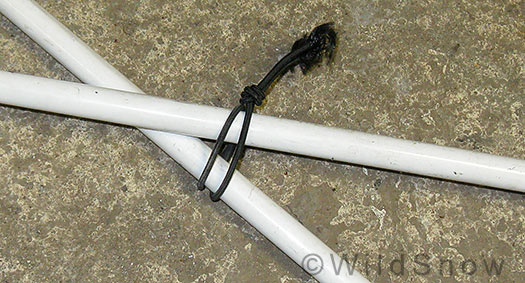
Lastly but still important, crossing the sled rods makes the sled move with your body during turns, and works against the sled flipping over. A rubber 0-ring or wrap of bungie is necessary at the center of the X, and it's good to anchor the wrap so it doesn't tend to migrate up or down the tubes (this wrap is not anchored.)
Lots of work rigging seven sleds and packs with all this stuff, but during testing we could easily feel the added efficiency so all the effort is worth it.
WildSnow.com publisher emeritus and founder Lou (Louis Dawson) has a 50+ years career in climbing, backcountry skiing and ski mountaineering. He was the first person in history to ski down all 54 Colorado 14,000-foot peaks, has authored numerous books about about backcountry skiing, and has skied from the summit of Denali in Alaska, North America’s highest mountain.

